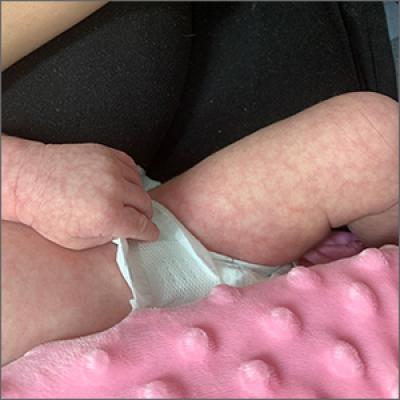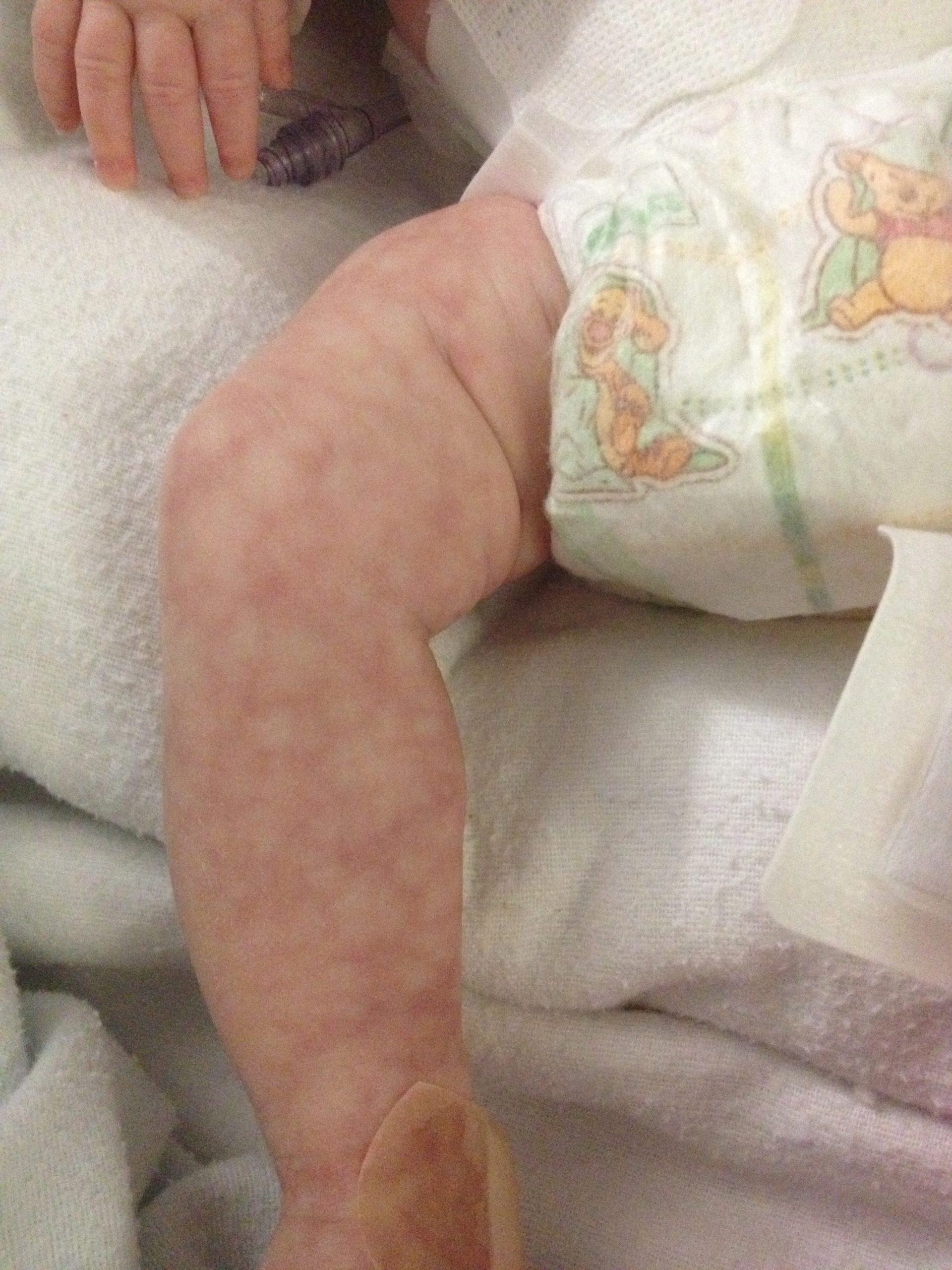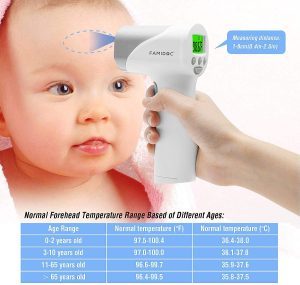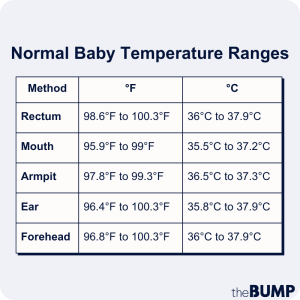A mottled skin baby can suffer from a condition that causes patchy or uneven skin coloration, commonly known as mottling. This condition can be caused by various factors, such as poor circulation, cold temperatures, or certain medical conditions.
Mottled skin is characterized by areas of discoloration, typically appearing as a mix of pink, purple, or blue patches. It may be more noticeable in cooler environments or during periods of illness. While mottled skin is generally not a cause for concern, it is essential to monitor the baby’s temperature and overall health.
Consulting a healthcare professional can help determine the underlying cause and provide appropriate guidance for management or treatment, if required.

Causes Of Mottled Skin In Babies
Mottled skin refers to a condition where a baby’s skin appears patchy or irregular in color, often with areas of pale and reddened skin. While mottled skin is usually harmless and temporary, it can be a cause for concern among parents. Understanding the causes of mottled skin in babies can help alleviate worries and provide appropriate care for your little one.
Blood flow regulation: In newborns and young infants, mottled skin can be a result of their developing circulatory system. Their blood vessels are still maturing, and as a result, the regulation of blood flow to the skin may be incomplete. This can lead to temporary changes in skin color and mottling.
Temperature
Temperature: Infants are more susceptible to temperature changes, which can affect their skin color. When a baby is exposed to cold temperatures, their body may constrict blood vessels near the skin’s surface to retain heat, causing mottled skin. Similarly, in hot weather, the body may dilate blood vessels to release heat, also resulting in mottling.
Stress or crying: Intense crying or excessive physical activity can temporarily affect blood flow, causing mottled skin. Stress and exhaustion can also lead to changes in blood circulation and result in patchy skin color.
Peripheral vascular disorders: Some medical conditions can affect the blood vessels in infants, leading to mottled skin. For example, conditions like Raynaud’s disease or peripheral artery disease can cause inadequate blood flow to the extremities, resulting in mottled skin.
Infection or illness: Certain infections or illnesses can affect blood circulation, leading to temporary mottling of the skin. Common examples include colds, the flu, or viral infections that cause fever. It’s important to consult a healthcare professional if your baby presents with other symptoms alongside mottled skin.
Medical disorders: In some cases, mottled skin may be a symptom of an underlying medical disorder, such as congenital heart disease, genetic disorders, or metabolic conditions. If you notice other concerning signs or your baby’s mottled skin persists, it is crucial to seek medical advice for a proper diagnosis.
Understanding the causes of mottled skin in babies can help parents distinguish between temporary physiological changes and potential medical issues. While mottled skin is typically harmless, it is always wise to consult a healthcare professional if you have any concerns or if other symptoms are present. Remember that every baby is unique, and some variation in skin color is normal and part of their development.
Physiological Factors
Physiological factors have a significant impact on mottled skin in babies, with physiological challenges often contributing to this condition. Understanding these factors is essential in addressing the underlying causes of mottled skin and providing appropriate care for affected babies.
Immature Circulatory System
Babies have __an immature circulatory system___ which can result in mottled skin. This system is still developing and may struggle to regulate blood flow effectively, leading to uneven skin coloring and temperature variations. The delicate nature of a baby’s circulatory system means that it is more susceptible to external factors, making it vital to keep a close eye on any signs of mottled skin and address them promptly.
Temperature Regulation Challenges
Baby’s skin, as a result of their __challenging of temperature regulation__, can become mottled. They may struggle to maintain a stable body temperature, especially in the first few weeks of life. This can lead to mottled skin as the blood vessels respond to changes in temperature by expanding and constricting in an attempt to assist the body in maintaining its ideal temperature. It’s crucial to regulate a baby’s environment to minimize temperature-related mottling and ensure their comfort and well-being.
Medical Conditions
Mottled skin in babies can be a sign of various medical conditions. Timely medical evaluation is necessary to identify the underlying cause and provide appropriate treatment for your little one.
Medical Conditions Mottled skin in babies can sometimes indicate underlying medical conditions that require urgent attention.
Hypothermia
Hypothermia occurs when a baby’s body temperature drops to dangerously low levels. This can happen due to prolonged exposure to cold or being dressed inadequately for the weather. A baby with mottled skin may be experiencing hypothermia, and it is crucial to warm them up gradually to prevent further complications. Signs of hypothermia in babies include shivering, cold skin, and lethargy. If you suspect hypothermia, seek medical help immediately.
Septic Shock
Septic shock can be a life-threatening condition that can cause mottled skin in babies. It is usually caused by a severe infection that leads to a sudden drop in blood pressure and inadequate blood flow to the body’s organs. Symptoms of septic shock in infants may include rapid breathing, a weak pulse, and altered mental status. If you notice these signs, seek emergency medical care without delay. In conclusion, mottled skin in babies can be a sign of serious medical conditions such as hypothermia and septic shock. It’s essential for parents to be vigilant and seek immediate medical attention if they notice mottled skin along with any other concerning symptoms.
Diagnosis Of Mottled Skin In Babies
Diagnosing mottled skin in babies requires a careful and thorough examination by medical professionals. Identifying the underlying cause of mottling is essential for determining the appropriate treatment and ensuring the baby’s well-being.
Physical Examination
A physical examination is the initial step in diagnosing mottled skin in babies. Healthcare providers will assess the baby’s skin color, temperature, and overall appearance. They will also evaluate the baby’s circulation and check for any signs of distress or discomfort.
Medical Tests
When mottled skin is observed, medical tests may be conducted to further investigate the underlying cause. These tests could include blood tests, imaging studies such as ultrasound or MRI, and other specialized examinations aimed at identifying any potential medical conditions contributing to the mottled appearance.
Treatment Options For Mottled Skin
Mottled skin in babies can be a concerning condition for parents. While it may not cause any harm, it is important to address this issue to ensure the well-being of your little one. In this article, we will discuss various treatment options for mottled skin and how to manage it effectively.
Monitoring Environment
The first step in treating mottled skin is to monitor the environment in which your baby spends most of their time. Maintaining a warm and comfortable room temperature is key, as extreme cold can worsen the condition. Use a thermometer to keep track of the temperature and aim to keep the room between 68-72°F (20-22°C).
It is also important to provide proper insulation and warmth for your baby. Dress them in layers of clothing and use blankets to keep them cozy and comfortable. Be cautious not to overdress, as this can lead to overheating and exacerbate the mottled skin condition.
Medical Interventions
If your baby’s mottled skin persists or is accompanied by other symptoms, it is important to seek medical intervention. Consulting a healthcare professional will help determine the underlying cause and provide appropriate treatment. Here are some medical interventions that may be recommended:
- Topical creams or ointments: Your doctor may prescribe specialized creams or ointments to alleviate mottled skin and promote better circulation.
- Medication: In some cases, medication might be prescribed to address any underlying medical conditions causing the mottled skin.
- Physical therapy: If mottled skin is a result of poor blood circulation, your healthcare provider may recommend exercises or physical therapy techniques to improve blood flow.
Remember, every baby is different, and the treatment options may vary depending on the underlying cause of mottled skin. It is crucial to consult a medical professional for an accurate diagnosis and personalized treatment plan.

Home Care Tips
When caring for a mottled skin baby at home, understanding the essential home care tips is crucial. Here are some practical ways to help keep your baby comfortable and healthy.
Keeping Baby Comfortable
- Use soft, breathable fabrics for clothing
- Keep the room temperature comfortable
- Provide gentle skin care with a mild, fragrance-free soap
- Ensure proper hydration with frequent feedings
Consulting Healthcare Provider
- Seek medical advice for persistent mottled skin
- Discuss any concerns with your pediatrician
- Follow recommendations for any necessary treatments
By following these home care tips and communicating with your healthcare provider, you can help ensure the well-being of your mottled skin baby.
Prevention Strategies
When it comes to protecting your baby from mottled skin, prevention strategies are key. By implementing the following measures, you can create a safe environment for your little one.
Maintaining Optimal Room Temperature
Keep the room temperature at a comfortable 68-72°F to prevent mottled skin in babies.
Proper Dressing Of The Baby
Select clothing that is suitable for the surrounding temperature to avoid skin discoloration.
What Causes Mottled Skin In Babies?
Mottled skin in babies is often caused by immature blood vessels close to the surface. It’s a normal response to temperature changes, stress, or excitement.
Why Does My Baby’s Skin Look Marbled?
Marbled skin in babies may be due to mottling, a common and normal condition. It often happens when the baby is cold or emotional.
What Does Mottled Skin Indicate?
Mottled skin may indicate poor circulation, anemia, or a severe infection. It can also be a sign of shock or a serious medical condition. If you notice mottled skin, seek medical attention promptly.
What Does It Mean If My Baby’s Skin Is Blotchy?
A blotchy skin on a baby usually indicates mild skin irritation or a harmless condition like newborn rash. It can also be caused by heat, cold, or an allergy. Keep your baby’s skin moisturized and clothing breathable. If the blotchiness persists or worsens, consult a pediatrician for advice.
Conclusion
Mottled skin in babies may be a common occurrence that is usually harmless and temporary. However, it is important for parents to be aware of any potential underlying causes or associated symptoms. Seeking medical advice is crucial to ensure the well-being of the baby and to alleviate any concerns.
By staying informed and proactive, parents can provide the necessary care and support for their little ones.





